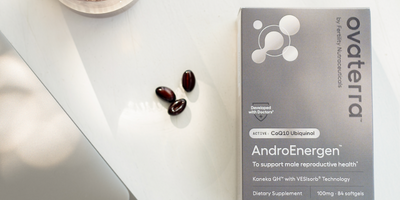The topic of AMH comes up frequently on the family building journey. Your healthcare provider may test your AMH levels during your pre-pregnancy period to provide insight into your reproductive health, especially for women.
Let’s dive deeper into what AMH is and what the different levels mean for your fertility.
What Are AMH Levels?
Anti-Mullerian Hormone (AMH) is the hormone naturally produced in the reproductive tissues of both men and women. It plays a vital role in sex differentiation of a fetus. Once we hit puberty, AMH is involved in the reproductive processes, including maturation of eggs in women.
Normal anti-mullerian hormone levels depend on your age and sex. Levels rise when you enter puberty and peak in your mid-twenties. After about 25, your levels start to decline.
AMH’s Role in Fetal Sex Differentiation
AMH plays an important role in the development of fetal sex organs. AMH levels are different depending on the sex of the baby, with the AMH values of male fetus usually being higher than the levels of a female fetus.
At about eight weeks after conception, the fetus has two sets of ducts. One is called the Mullerian ducts, which eventually develop into female reproductive organs; the other, called Wolffian ducts, develop into male reproductive organs.
In a male fetus with XY chromosomes, the Sertoli cells of the embryonic testes secrete AMH, which causes the female (Mullerian) ducts to disappear. The Wolffian ducts develop into different parts of the male reproductive system.
In a female fetus with XX chromosomes, the absence of AMH leads to Mullerian ducts developing into the female reproductive organs, including the fallopian tubes, uterus, cervix, and the upper part of the vagina.
This differentiation happens quickly within a 2-week window between 8 and 10 weeks after conception.
Let’s next look at the role that AMH plays in female reproductive health, years after birth.
What Do AMH Levels Have to Do With Fertility?
In adult women, AMH, a glycoprotein hormone, is produced in the granulosa cells of the ovarian follicles (fluid-filled sacs on the ovaries that hold eggs). Mainly produced by preantral and antral follicles that contain very immature eggs, AMH levels are used by doctors to assess an important aspect of female fertility: The ovary’s ability to produce good-quality mature eggs.
Antral follicle count is another metric many fertility specialists use to gauge a woman’s ovarian reserve. Simply put, ovarian reserve is the number of healthy immature eggs (also called oocytes) stored in the ovaries. The more eggs you have in the ovaries, the more likely you are to get pregnant, so ovarian reserve is an important factor in your reproductive health.
Higher AMH levels indicate a higher ovarian reserve. Conversely, lower AMH levels signal low ovarian reserve.
As you age, the number of eggs left in the ovaries decreases, which is one of the reasons women find it more difficult to get pregnant after 35 or 40. Importantly, AMH measurements are just one measure of your reproductive health - and having low or high AMH levels in isolation might not give you the full picture of your chances of getting pregnant.
Doctors may also test your follicle stimulating hormone (FSH) and estradiol. FSH levels, especially if looked at in conjunction with estradiol levels, are another measure of your ovarian function.
How Do I Know My AMH Levels?
You can test your AMH levels by taking an anti-mullerian hormone test. Unlike FHS tests that need to be done on day-2 or -3 of your cycle, an AMH test can be conducted anytime during your menstrual cycle. It requires a blood draw, but no special preparation beforehand.
After the blood sample is sent to a lab, it can take a few days to get the results back. If your healthcare provider ordered this test, you usually have a follow-up appointment to discuss your AMH test results and what to do next.
The AMH test has very little to no risk. You may feel a little pain at the site of the blood draw, but that’s usually about it.
While some studies may state a “normal AMH level” (like this one, which defines “normal” as 2-6.8 ng/mL), what’s normal depends on your age, with older women generally having lower AMH levels than younger women, reflecting lower ovarian reserve. Normal ranges also vary a bit from lab to lab.However, in general, AMH of less than 0.3-0.5 ng/mL is considered very low.
Why Should I Take an AMH Test?
AMH levels are an important indicator of one aspect of your reproductive health. A healthy AMH level is a sign that your ovarian reserve is in a healthy place for conception. So, an AMH test can arm you with the knowledge to support your TTC (trying to conceive) journey.
If you are concerned about your ovarian health or your TTC journey in general, you may want to consider talking to your doctor about getting an AMH test.
Your doctor might also check your level of AMH for the following reasons:
- You are having difficulty becoming pregnant
- To predict menopause
- To monitor women who have ovarian health concerns
What AMH Level Do You Need To Get Pregnant?
The averages for AMH levels for women differ depending on age, and doctors disagree about what a “good” level is. Still, an AMH level of 1.0 ng/mL or higher is generally considered good enough for women of reproductive age. If you are younger, your AMH should be higher.
That said, AMH is just one way to learn about your fertility. Women with normal AMH levels still need other aspects of the reproductive processes working properly - including the normal anatomy of the fallopian tubes and the uterus, a healthy balance of other reproductive hormones, normal ovulation, a healthy uterine environment to welcome an implanting embryo and so on.
What Can a High AMH Level Mean?
Higher levels of AMH could indicate more antral follicles and a higher number of eggs, which can ultimately lead to higher pregnancy chances. However, higher is not better. An abnormally high level of AMH can mean that there are too many eggs stuck at the immature stage and not developing toward ovulation, because that’s the stage at which follicles produce AMH. This can be a sign that something is off in the process of egg maturation.
Usually, the quantity and quality of eggs go hand-in-hand. So, when you have a good number of eggs, indicated by a normal AMH level, it’s often the case that your egg quality is also good.
What Can Low AMH Levels Mean?
Low levels of AMH usually indicate that you have fewer eggs in the ovaries. This could be a natural part of aging, or due to other factors. AMH levels under 1.0 ng/mL are typically considered low for young women, suggesting a depleted supply of eggs. AMH levels less than 0.1 ng/mL could also indicate a woman has begun menopause.
There are no clear symptoms of having low levels of AMH. Here are some possible causes of low AMH:
- Age
- Diet
- Mental health
- Environmental causes
- Genetics
What Can an Irregular AMH Level Mean?
When your AMH levels appear to be irregular, your doctor will likely do more tests to understand what may be going on. Irregular levels can be because of natural causes or could indicate an underlying issue. For example, when a woman starts the process toward menopause, this could cause an irregularity in AMH levels.
Menopause
A woman is considered to have entered menopause if she has gone 12 months since her last period. During this time, the number of immature eggs left in the ovaries becomes quite low, and AMH levels naturally decrease. Menopause usually happens between the ages of 45 and 55 and lasts approximately 14 years.
Your AMH levels can be a predictor of menopause. In recent studies, AMH was found to be a good ovarian reserve marker for predicting age at menopause.
Can AMH Levels Change?
As we've seen, AMH levels can change due to natural reasons and in response to some medical treatments. Of course, AMH levels change naturally as you age. AMH levels typically have only minor fluctuations during childhood and adolescence.
AMH is a quantitative marker of ovarian follicles, even in young girls. AMH levels peak in the early twenties but begin to decline slowly afterward. Toward menopause, AMH is almost undetectable.
During some months of menstruation, you may have higher levels of AMH than others. Again, this could indicate that you could have more eggs maturing one month than another. The fluctuations within a single menstrual cycle are generally minor.
The Bottom Line
The anti-Mullerian hormone plays a significant role in egg maturation and the growth of sex organs before a baby is born. Your healthcare provider may test your AMH levels for various reasons, especially when you need to know more about your ovarian reserve.
While AMH is not a single indicator of fertility, it can provide you with clues to help you move forward with your family building process. For some, the journey to motherhood may take more time, so it is important to speak with your doctor about supporting your chances of conception.
Reach out to us to learn more about fertility testing, including AMH, and what you can do to support your reproductive health based on the results. We are with you.
Ovaterra provides reproductive health resources for general, educational purposes only. This content is not intended to replace medical advice from a qualified healthcare professional. Similarly, when making your financial decisions, please consult qualified financial professionals who can make individual recommendations.












